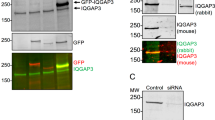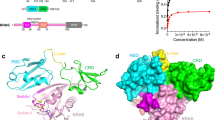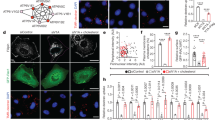Abstract
Ras proteins regulate cellular growth and differentiation, and are mutated in 30% of cancers. We have shown recently that Ras is activated on and transmits signals from the Golgi apparatus as well as the plasma membrane1,2 but the mechanism of compartmentalized signalling was not determined. Here we show that, in response to Src-dependent activation of phospholipase Cγ1, the Ras guanine nucleotide exchange factor RasGRP1 translocated to the Golgi where it activated Ras. Whereas Ca2+ positively regulated Ras on the Golgi apparatus through RasGRP1, the same second messenger negatively regulated Ras on the plasma membrane by means of the Ras GTPase-activating protein CAPRI3. Ras activation after T-cell receptor stimulation in Jurkat cells, rich in RasGRP1, was limited to the Golgi apparatus through the action of CAPRI, demonstrating unambiguously a physiological role for Ras on Golgi. Activation of Ras on Golgi also induced differentiation of PC12 cells, transformed fibroblasts and mediated radioresistance. Thus, activation of Ras on Golgi has important biological consequences and proceeds through a pathway distinct from the one that activates Ras on the plasma membrane.
This is a preview of subscription content, access via your institution
Access options
Subscribe to this journal
Receive 51 print issues and online access
$199.00 per year
only $3.90 per issue
Buy this article
- Purchase on Springer Link
- Instant access to full article PDF
Prices may be subject to local taxes which are calculated during checkout





Similar content being viewed by others
References
Choy, E. et al. Endomembrane trafficking of ras: the CAAX motif targets proteins to the ER and Golgi. Cell 98, 69–80 (1999)
Chiu, V. K. et al. Ras signalling on the endoplasmic reticulum and the Golgi. Nature Cell Biol. 4, 343–350 (2002)
Lockyer, P. J., Kupzig, S. & Cullen, P. J. CAPRI regulates Ca(2 + )-dependent inactivation of the Ras-MAPK pathway. Curr. Biol. 11, 981–986 (2001)
Cullen, P. J. & Lockyer, P. J. Integration of calcium and Ras signalling. Nature Rev. Mol. Cell Biol. 3, 339–348 (2002)
Yue, L., Peng, J. B., Hediger, M. A. & Clapham, D. E. CaT1 manifests the pore properties of the calcium-release-activated calcium channel. Nature 410, 705–709 (2001)
Ji, Q. S., Ermini, S., Baulida, J., Sun, F. L. & Carpenter, G. Epidermal growth factor signaling and mitogenesis in Plcγ1 null mouse embryonic fibroblasts. Mol. Biol. Cell 9, 749–757 (1998)
Ehrhardt, A., Ehrhardt, G. R., Guo, X. & Schrader, J. W. Ras and relatives—job sharing and networking keep an old family together. Exp. Hematol. 30, 1089–1106 (2002)
Baron, C. L. & Malhotra, V. Role of diacylglycerol in PKD recruitment to the TGN and protein transport to the plasma membrane. Science 295, 325–328 (2002)
Bankaitis, V. A. Slick recruitment to the Golgi. Science 295, 290–291 (2002)
Ebinu, J. O. et al. RasGRP links T-cell receptor signaling to Ras. Blood 95, 3199–3203 (2000)
Dower, N. A. et al. RasGRP is essential for mouse thymocyte differentiation and TCR signaling. Nature Immunol. 1, 317–321 (2000)
Park, W., Mosteller, R. D. & Broek, D. Identification of a dominant-negative mutation in the yeast CDC25 guanine nucleotide exchange factor for Ras. Oncogene 14, 831–836 (1997)
Brummelkamp, T. R., Bernards, R. & Agami, R. A system for stable expression of short interfering RNAs in mammalian cells. Science 296, 550–553 (2002)
Ebinu, J. O. et al. RasGRP, a Ras guanyl nucleotide-releasing protein with calcium- and diacylglycerol-binding motifs. Science 280, 1082–1086 (1998)
Tognon, C. E. et al. Regulation of RasGRP via a phorbol ester-responsive C1 domain. Mol. Cell Biol. 18, 6995–7008 (1998)
Peppelenbosch, M. P. et al. Rac-dependent and -independent pathways mediate growth factor-induced Ca2+ influx. J. Biol. Chem. 271, 7883–7886 (1996)
Lewis, R. S. Calcium signaling mechanisms in T lymphocytes. Annu. Rev. Immunol. 19, 497–521 (2001)
Marshall, C. J. Specificity of receptor tyrosine kinase signaling: transient versus sustained extracellular signal-regulated kinase activation. Cell 80, 179–185 (1995)
Yamashita, S. et al. CalDAG-GEFIII activation of Ras, R-ras, and Rap1. J. Biol. Chem. 275, 25488–25493 (2000)
Acknowledgements
We thank J. Stone for anti-RasGRP1 antibodies, G. Carpenter for PLC-γ-/- cells and E. Skolnik and B. Neel for critically reading the manuscript. This work was supported by grants from the National Institutes of Health (to M.R.P., A.P. and A.D.C), the New York State Breast Cancer Research Program and the Burroughs Wellcome Fund (to M.R.P.), and the Lister Institute (to P.J.C.).
Author information
Authors and Affiliations
Corresponding author
Ethics declarations
Competing interests
The authors declare that they have no competing financial interests.
Rights and permissions
About this article
Cite this article
Bivona, T., Pérez de Castro, I., Ahearn, I. et al. Phospholipase Cγ activates Ras on the Golgi apparatus by means of RasGRP1. Nature 424, 694–698 (2003). https://doi.org/10.1038/nature01806
Received:
Accepted:
Published:
Issue Date:
DOI: https://doi.org/10.1038/nature01806
This article is cited by
-
CD6-mediated inhibition of T cell activation via modulation of Ras
Cell Communication and Signaling (2022)
-
The role of ral signaling and post translational modifications (PTMs) of Ras in cancer
Genome Instability & Disease (2022)
-
Spatial regulation and generation of diversity in signaling pathways
Journal of Biosciences (2021)
-
Excess diacylglycerol at the endoplasmic reticulum disrupts endomembrane homeostasis and autophagy
BMC Biology (2020)
-
Recent advances in the clinical development of immune checkpoint blockade therapy
Cellular Oncology (2019)
Comments
By submitting a comment you agree to abide by our Terms and Community Guidelines. If you find something abusive or that does not comply with our terms or guidelines please flag it as inappropriate.



